dutch bio-med PhD, practicioner of the unholy combination of dance and martial arts, eldritch collectioner of crafty hobbies, blithe follower of life's path and so far enjoying most of it. she/her and they/them (both are correct) and just generally queer and here.
Last active 4 hours ago
Don't wanna be here? Send us removal request.
Text
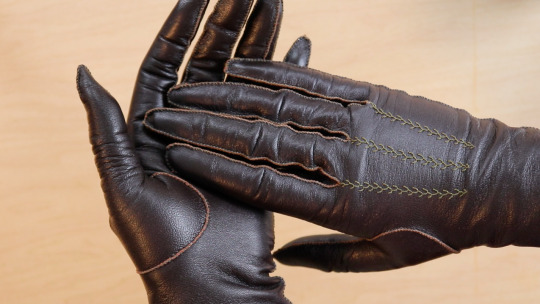

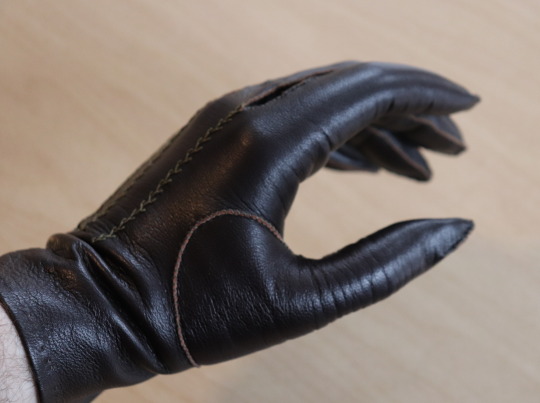




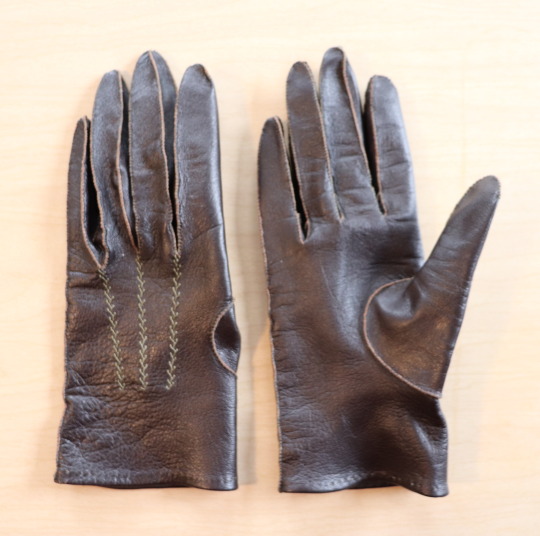
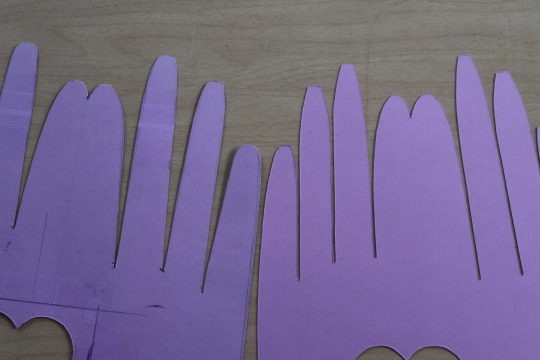
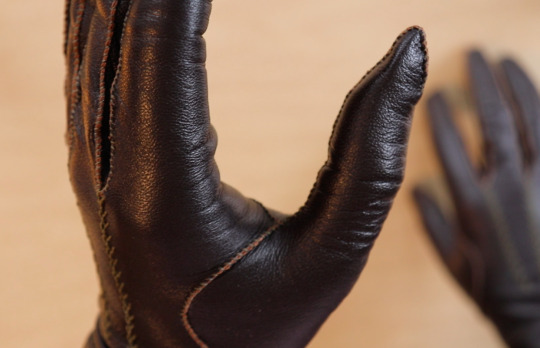
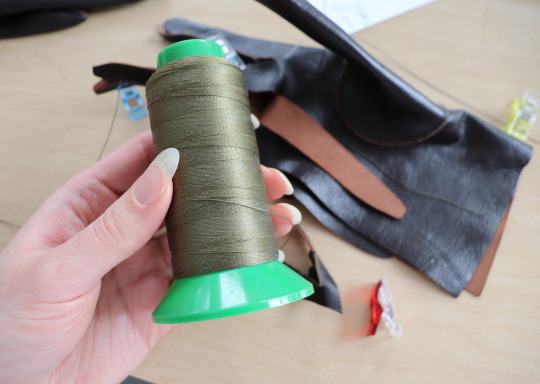

Finished another pair of gloves last week, this time in dark brown leather from ItalianSkins and sewn up with some olive green silk thread that was a very lucky thrift store find. (It was in a mixed baggie and I didn't know it was silk until I got home!)
In my glove video I mentioned wanting to re-draw my pattern so the fingers are angled in more tightly, and so the thumb piece is longer, and I did that for these. The thumb fits much better, and the bases of the fingers are no longer too loose.
I also tried the straighter style of fourchettes, but didn't like them as much as the V shaped ones. I think the curved edges put a bit too much material onto the backs of the fingers and made them wrinklier. (Though this particular leather is not the stretchiest, so it may be better with a stretchier one.)
I did 3 rows of feather stitch on the back of the hand, since I'd seen that on an extant pair and thought it looked nice. I used a regular needle for that part because I was worried a leather needle would damage the thread.
5K notes
·
View notes
Text

Aaaand both ribbons are now done and neatly finished with only three days to spare! Whoopwhoop!
I am kinda proud of both although I like the right ribbon better. The left one has an unfortunate tendency to bubble a bit which I think is because it involved 16 turns forward and back. We'll see if it settles a bit over time and otherwhise I will see what a quick press of the iron will do...
Also for those that it interests here is how they will look when braided in.

Do I have long hair? Yes. Did I sneak in some more length with the ribbons? Also yes...
#my art#tablet weaving#card weaving#weaving#weavers of tumblr#castlefest#Tessiël of the Northern Woods
146 notes
·
View notes
Text

Castlefest 2023 was wet. Really really wet. So wet that on the last day, my wet shoes had chafed my feet open, and I just gave up on having dry feet altogether and just went about splashing barefoot in all the puddles I could find. I also decided I wanted an in character umbrella. I wanted to already have it for Castlefest 2024 but I was also really busy last year with the Hanseatic Days so I ended up not finishing it in time. Luckily last year we had nice dry weather most of the time without it being too hot so I didn't end up missing it. This year however looks like its going to be a bit wetter edition again ( at least if the current weather pattern holds) so time to finish my umbrella!
And so there we have it. Waterproof fabric over an umbrella frame I bought on etsy with some judicious use of textile markers to make them look like overlapping chestnut leaves... textile markers and textile paint are usually meant to be used on cotton and not on whatever unholy blend of polyester and silicone waterproof fabric usually is so the paint is not very vivid but it did end up looking like chestnut leaves so I am fairly happy
83 notes
·
View notes
Text

Throughout all the sewing I've been doing I've also steadily chipped away at the weaving for Tessiël 's hair ribbons. Ribbon number one is now mostly done, I still need to neaten up one of the edges and shorten it a bit since I have long hair but not that long. This however will have to wait untill I finish the second one so I can make sure they will be the same lengths. Luckily number two is also underway and given that it is not a very complicated pattern I don't think it will take much time...
#my art#card weaving#tablet weaving#weaving#weavers of tumblr#Tessiël of the Northern Woods#castlefest
71 notes
·
View notes
Text
"People have been telling stories about renewable energy since the nineteen-seventies, when the first all-solar-powered house opened on the campus of the University of Delaware, drawing a hundred thousand visitors in 1973, its first year, to marvel at its early photovoltaic panels and its solar hot-water system, complete with salt tubs in the basement to store heat overnight. But, even though we’ve got used to seeing solar panels and wind turbines across the landscape in the intervening fifty years, we continue to think of what they produce as “alternative energy,” a supplement to the fossil-fuelled power that has run Western economies for more than two centuries. In the past two years, however, with surprisingly little notice, renewable energy has suddenly become the obvious, mainstream, cost-efficient choice around the world. Against all the big bad things happening on the planet (and despite all the best efforts of the Republican-led Congress in recent weeks), this is a very big and hopeful thing, which a short catalogue of recent numbers demonstrates:
It took from the invention of the photovoltaic solar cell, in 1954, until 2022 for the world to install a terawatt of solar power; the second terawatt came just two years later [in 2024], and the third will arrive either later this year or early next [in 2025 or early 2026].
That’s because people are now putting up a gigawatt’s worth of solar panels, the rough equivalent of the power generated by one coal-fired plant, every fifteen hours. Solar power is now growing faster than any power source in history, and it is closely followed by wind power—which is really another form of energy from the sun, since it is differential heating of the earth that produces the wind that turns the turbines.
Last year, ninety-six per cent of the global demand for new electricity was met by renewables, and in the United States ninety-three per cent of new generating capacity came from solar, wind, and an ever-increasing variety of batteries to store that power.
In March, for the first time, fossil fuels generated less than half the electricity in the U.S. In California, at one point on May 25th, renewables were producing a record hundred and fifty-eight per cent of the state’s power demand. Over the course of the entire day, they produced eighty-two per cent of the power in California, which, this spring, surpassed Japan to become the world’s fourth-largest economy.
Meanwhile, battery-storage capability has increased seventy-six per cent, based on this year’s projected estimates; at night, those batteries are often the main supplier of California’s electricity. As the director of reliability analysis at the North American Electric Reliability Corporation put it, in the CleanTechnica newsletter, “batteries can smooth out some of that variability from those times when the wind isn’t blowing or the sun isn’t shining.” As a result, California is so far using forty per cent less natural gas to generate electricity than it did in 2023, which is the single most hopeful statistic I’ve seen in four decades of writing about the climate crisis.
Texas is now installing renewable energy and batteries faster than California; in a single week in March, it set records for solar and wind production as well as for battery discharge. In May, when the state was hit by a near-record-breaking early-season heat wave, air-conditioners helped create a record demand on the grid, which didn’t blink—more than a quarter of the power came from the sun and wind. Last week’s flooding tragedy was a reminder of how vulnerable the state is to extreme weather, especially as water temperatures rise in the Gulf, producing more moisture in the air; in late June, the director of the state’s utility system said that the chances of emergency outages had dropped from sixteen per cent last summer to less than one per cent this year, mostly because the state had added ten thousand megawatts of solar power and battery storage. That, he said, “puts us in a better position.”
All this is dwarfed by what’s happening in China, which currently installs more than half the world’s renewable energy and storage within its own borders, and exports most of the solar panels and batteries used by the rest of the world. In May, according to government records, China had installed a record ninety-three gigawatts of solar power—amounting to a gigawatt every eight hours. The pace was apparently paying off—analysts reported that, in the first quarter of the year, total carbon emissions in China had actually decreased; emissions linked to producing electricity fell nearly six per cent, as solar and wind have replaced coal. In 2024, almost half the automobiles sold in China, which is the world’s largest car market, were full or hybrid electric vehicles. And China’s prowess at producing cheap solar panels (and E.V.s) means that nations with which it has strong trading links—in Asia, Africa, South America—are seeing their own surge of renewable power.
In South America, for example, where a decade ago there were plans to build fifteen new coal-fired power plants, as of this spring there are none. There’s better news yet from India, now the world’s fastest-growing major economy and most populous nation, where data last month showed that from January through April a surge in solar production kept the country’s coal use flat and also cut the amount of natural gas used during the same period in 2024 by a quarter. But even countries far from Beijing are making quick shifts. Poland—long a leading coal-mining nation—saw renewable power outstrip coal for electric generation in May, thanks to a remarkable surge in solar construction. In 2021, the country set a goal for photovoltaic power usage by 2030; it has already tripled that goal.
Over the past fifteen years, the Chinese became so skilled at building batteries—first for cellphones, then cars, and now for entire electric systems—that the cost of energy storage has dropped ninety-five per cent. On July 7th, a round of bidding between battery companies to provide storage for Chinese utilities showed another thirty per cent drop in price. Grid-scale batteries have become so large that they can power whole cities for hours at a time; in 2025, the world will add eighty gigawatts of grid-scale storage, an eightfold increase from 2021. The U.S. alone put up four gigawatts of storage in the first half of 2024.
There are lots of other technologies vying to replace fossil fuels or to reduce climate damage: nuclear power, hydrogen power, carbon capture and storage; along with renewables, all were boosted by spending provisions in Biden’s Inflation Reduction Act and will be hampered to varying degrees by congressional rollbacks. Some may prove useful in the long run and others illusory, but for now they are statistically swamped by the sheer amount of renewable power coming online. Globally, roughly a third more power is being generated from the sun this spring than last. If this exponential rate of growth can continue, we will soon live in a very different world.
All this suggests that there is a chance for a deep reordering of the earth’s power systems, in every sense of the word “power,” offering a plausible check to not only the climate crisis but to autocracy. Instead of relying on scattered deposits of fossil fuel—the control of which has largely defined geopolitics for more than a century—we are moving rapidly toward a reliance on diffuse but ubiquitous sources of supply. The sun and the wind are available everywhere, and they complement each other well; when sunlight diminishes in the northern latitudes at the approach of winter, the winds pick up. This energy is impossible to hoard and difficult to fight wars over. If you’re interested in abundance, the sun beams tens of thousands of times more energy at the earth than we currently need. Paradigm shifts like this don’t come along often: the Industrial Revolution, the computer revolution. But, when they do, they change the world in profound and unpredictable ways...
In retrospect, it’s reasonably easy to see how fast solar and wind power were coming. But, blinkered by the status quo, almost no one actually predicted it. In 2009, the International Energy Agency predicted that we would hit two hundred and forty-four gigawatts of solar capacity by 2030; we hit it by 2015. For most of the past decade, the I.E.A.’s five-year forecasts missed [underestimated the amount of renewables] by an average of two hundred and thirty-five per cent. The only group that came even remotely close to getting it right was not J. P. Morgan Chase or Dow Jones or BlackRock. It was Greenpeace, which estimated in 2009 that we’d hit nine hundred and twenty-one total gigawatts by 2030. We were more than fifty per cent above that by 2023. Last summer, Jenny Chase, who has been tracking the economics of solar power for more than two decades for Bloomberg, told the Times, “If you’d told me nearly 20 years ago what would be the case now, 20 years later, I would have just said you were crazy. I would have laughed in your face. There is genuinely a revolution happening.”
-via The New Yorker, July 9, 2025
5K notes
·
View notes
Text












Another thing that had been on The Pile for a long time was this space waistcoat! I dye painted this piece of cotton back in 2015 when we were doing silk painting in Textiles class. I think I started cutting the waistcoat about 2 years ago, covered the buttons, and then got distracted. I had to piece part of one shoulder because I'd already used up part of the fabric to make a couple of handkerchiefs, but I don't think it's too noticeable. After dyeing the cotton I had splattered some fabric ink on it and painted a few stars, but after lining the fronts recently I painted a lot more stars on, and then painted glow in the dark ink on top.
It was a bit tricky to get photos of the glowing, and the first two are brighter than it looks in real life, at least with the small amount of charging it had when I took them. I also did a running stitch around the edges with glow in the dark thread which I've had for at least a decade and never used! Then I accidentally melted part of it with my iron and had to redo that bit.
The lining is a thrifted cotton sateen bedsheet and the back is blue linen from I forget where. The buttonholes are done by machine first, same as the last one, and then covered in silk twist.
2K notes
·
View notes
Text
When I first created Tessiël many years ago to try out LARPing I had immediately decided that as a ranger she needed something for camouflage. So with a lot of help of my darling mom ( since I had just started sewing) I made her a green and brown Patchwork cloak... it was a lot of work but in the end it was still mostly a weirdly shaped square that didn't have a lot of flow and I was a bit disappointed by it... a couple of years later when I dusted Tessiël of to go to Castlefest for the first time I decided I wanted to do something else with that cloak. I had just seen the Incredibles( yes it took me a really long time to see that movie) and Edna Mode's strident "No Capes!" was still very fresh in my mind. So I cut up the cloak and made a haori out of it. That served me much better than the cape but throughout the years that haori had faded a lot and had started fraying at quite a few seams. And since I discovered during the move to my new apartment that I have a lot of green scraps...well time to see if I could remake that haori but better this time.
First of course the pattern which i based on my black haori and the cutting

As you can see at the end of it I was running out of pins.
Then sewing all those pieces for the base haori together. The camera, by the way is not doing all those mossy greens and olives any justice.

Of course since I like to make my own life difficult I decided to add a brighter green leaf shaped shoulder piece that took almost the same amount of time as the base haori.

And then of course it was time to add the collar and close the side seams and the sleeves

And last but not least a few pictures of it worn with most of the rest of the costume... I am missing the vambraces and the shinguards and obviously I haven't braided my hair or added my little pointy ears

#my art#sewing#quilting#quilters of tumblr#quiltblr#sewists of tumblr#castlefest#haori#costuming#Tessiël of the Northern Woods
39 notes
·
View notes
Text
21. Flintknapper
22. Painter
While early 20th century illustrations often depicted men being the ones that painted the caves there have been recent studies on the handprints in some of those caves that prove that at least some of those painters were women
23. Sculptor
Excellent arguments have been made that the female statues with huge breasts and buttocks were actually carved by women who without a mirror to see themselves from an outside perspective, only had the forced perspective they had of themselves when they looked down as a reference to represent themselves
24. Nurse
We are a collaborative species, you betcha some women would have nursed an other woman's child if it was necessary
25. Spinner
If you want to weave you have to spin first
26. Teacher
Again, what has always been the strength of the human species is collaboration and the pooling and expansion of our knowledge. Whatever knowledge women had, they definitely have passed it on to others
27. Seamstress
Clothes don't preserve well but the thousands of beads found in some graves suggest they were most likely sewn on garments
28. Embroiderer
See argument above
29. Surgeon
There have been a few very early skeletons that bear the traces of successful operations like amputations and trepanations. Who is to say that women who definitely functioned as midwives did not expand their expertise to other medical interventions
30. Lumberjack/firewood gatherer
Even if you believe women were mostly gatherers and men mostly hunters, that would make women the ones who have the time and opportunity to gather wood and chop down trees
31. Bowyer/fletcher
If you are the one chopping down trees, why not take it a step further?
32. Brewers
Up until recently beerbrewers were all women and it is the oldest available alcoholic beverage
professions older than prostitution because i’m so tired of hearing that misogynistic talking point created by a british imperialist witnessing impoverished women in india
1. hunter
2. forager
3. midwife
4. babysitter
5. weaver
6 doctor/healer
7. shaman
8. fisher
9. stonemason
10. navigator
11. sentry
12. butcher
13. cook
14. storyteller
15. woodcarver
16. food tester
17. builder
18. tanner/leatherworker
19. scout
20. fire tender
there is no evidence of prostitution’s existence until the neolithic agricultural revolution, stemming from an unequal resource distribution and the rise of female oppression. for reference, the start of agriculture until now comprises less than 5% of homo sapien history. do not let men tell you misogyny is a natural part of life. it’s not.
2K notes
·
View notes
Text


Originally this lilypad quilt was going to be a babyblanket for a baby I was fairly sure I was going to call my nibling... Halfway through the process however my ex broke up with me and I wasn't feeling charitable enough to finish it and gift it to my now ex-brother-in-law anyway.... So I set it aside and focused on moving on and finding a new place to live.... but I had already finished the top and I loved the design so I figured I might turn this particular lemon into some good lemonade after all...after finding I had enough leftovers to frankenstein a big enough piece of batting I finished it all in one go today and now I have a (picnic) blanket for Tessiël's kit on the first weekend of august and a nice new sofa quilt during the rest of the year
#my art#sewing#blanket#quilt#lilypad quilt#quilting#patchwork#quiltblr#quilters of tumblr#Tessiël of the Northern Woods#castlefest
234 notes
·
View notes
Text
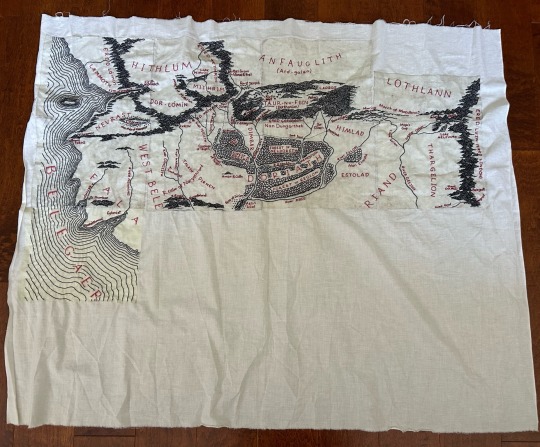
Panel 9 is done! Thanks to a combination of there only being the sea (so much simpler to stitch!) and wonderful weather to sit on my balcony and just get lost in the crafting zone, it got completed far quicker than expected.
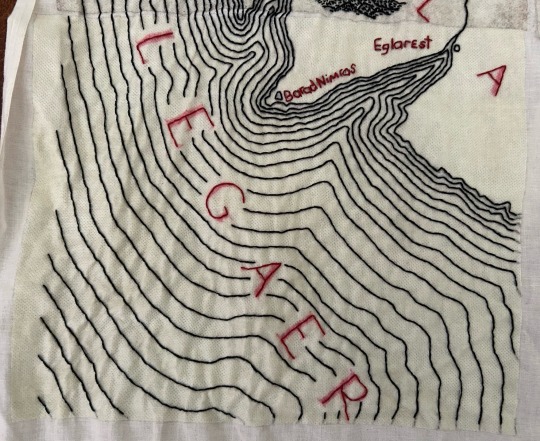
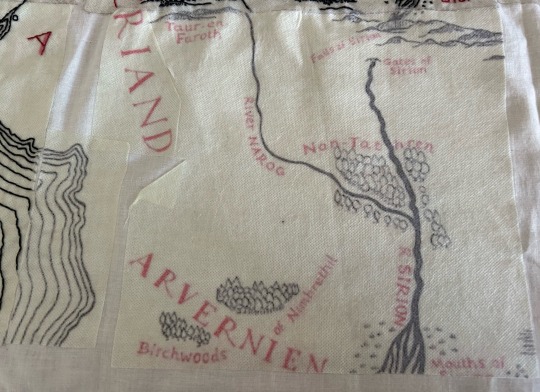
Now for Panel 10! There was a tiny issue in sizing so I had to cut up a few pieces and puzzle them in, but the pattern paper will all get washed away at the end anyway so it’s all good.
#beleriand embroidery project#embroidery#fibre art#Tolkien#silmarillion#ideas for later#embroiderers of tumblr
228 notes
·
View notes
Text
Ever since the extremely hot and extremely dry Castlefest edition of 2018 I've had a bandana as part of Tessiël 's kit. Turns out that a wet bandana around your head really helps with keeping you a bit cooler...
It's a fairly simple thing, just a square of green muslin but it does it's job well... however as I've been steadily updating and upgrading Tessiël's stuff through the years it was starting to look a bit out of place. Then a couple of months back I also stumbled over @vincentbriggs 's leaf headkerchief tutorial and I knew I needed to make one for Tessiël.
Birches are my favourite trees so I immediately knew it had to be based on a birch leaf

It didn't make my life any easier since it turns out that sewing and later topstitching all those teeny-tiny teeth does take a lot of effort...

And that's not even taking into account all the tiny points and angles that need to be trimmed and then carefully turned out.

The end result of this all didn't turn out as neat as the ones Vincent shows in his tutorial but it is serviceable enough and after slipstitching the facing I set out to the part I was looking forward to the most aka painting the damn thing.

I first painted the veins in light green, and since I was a bit messy, I added some green spatters to hide the fact I had stained the fabric with the paint on my hand.... after concluding that it also needed a bit of extra oomph, I lastly overpainted the main veins with some silver paint, providing at the same time an echo to the vambraces and shinguards I had made two years ago which are also green with silver veins...
Then it was a matter of letting it all dry and a quick press of the iron to set the textile paint

And voilà! A brand new banging headkerchief for Tessiël. Now the only question will be how it will stand up to being repeatedly wetted and wrung out if this year's Castlefest turns out to be a hot edition again.

PS: @vincentbriggs Many, many thanks for your amazing tutorial!!!
#my art#sewists of tumblr#sewblr#sewing#headkerchief#vincentbriggs#castlefest#Tessiël of the Northern Woods#bandana#leafkerchief
133 notes
·
View notes
Text
Fellowship Cloak Weaving Draft
Hi all! I've been kind of quiet on this blog, but I have something really exciting to share today: after six years, I FINALLY figured out the weaving draft for the Fellowship cloaks from Lord of the Rings.
This is a problem I've been trying to figure out since shortly after I made my Legolas cosplay in 2018. The cloaks that the nine members of the Fellowship receive in Lothlórien look like a nondescript gray fabric from far away, but zoom in and you'll see a very complex pattern of horizontal and vertical bars of dark gray and white.
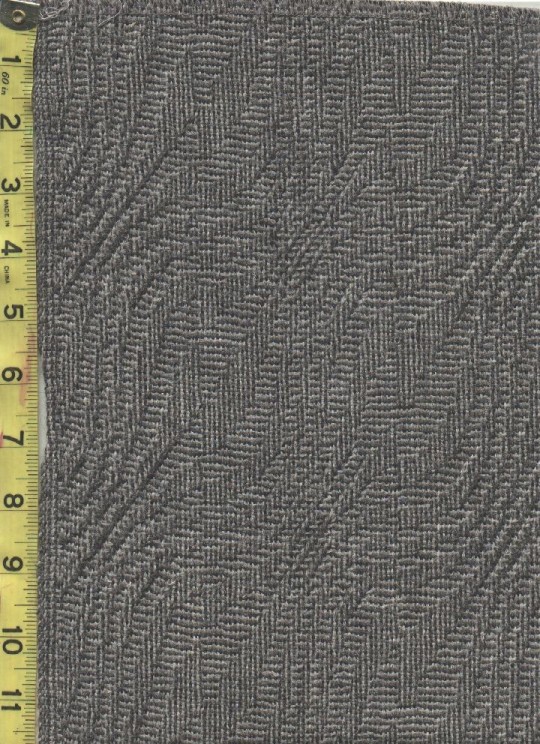
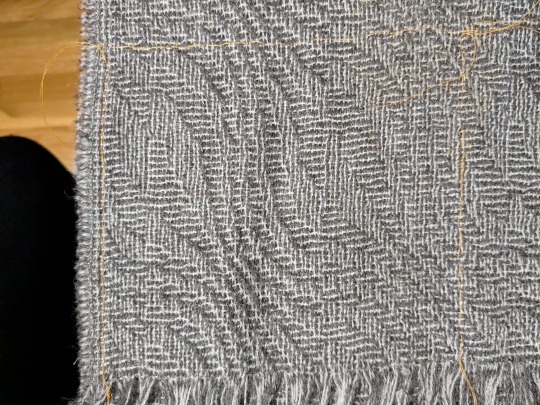
(First image from Alleycatscratch, second is a photo of the scarf of the same fabric I bought from Stansborough where I was attempting to trace the pattern repeat with orange thread)
This is going to be a long post, so I'm just going to lead with the completed draft:

Imagine me Will Smith wife posing at this for the last 24 hours.
It's got the correct size of pattern repeat! It's got the five individual ripples! It's got that dumb little pattern break in the middle that breaks up the center of the leaf motif! I am OVER THE MOON about figuring this out, especially starting out with very little knowledge about weaving drafts in general. More ramblings about this type of draft and my thought process below:
This particular pattern is known as "shadow weave," a subset of color-and-weave where the pattern is created from the interplay of different warp and weft colors plus the weaving draft itself. To get an idea of how that works, let's start by looking at plain weave in one color:

The solid purple bar at the top indicates the color of the warp threads, and the solid purple bar at the right indicates the color of the weft threads. So far we've got our basic under-over-under-over pattern in a single, solid color (purple). But what if we add an additional color (green) to the warp, and alternate those colors? Then we'd get a speckled fabric like this:

The visual effect looks pretty much identical regardless of if you start with green or purple. However, if you also alternate purple and green in the weft, it produces a very different effect depending on if you start with purple or green (note the differences in the bar on the right):


So cool, now we can make either vertical or horizontal stripes! If you double up on the colored threads in some areas, you can even flip between the two and start dividing the fabric into "blocks," like so:


Note that with all these changes, the only thing we've been doing is changing the order of the colors in the warp and weft. The actual weave structure itself is still just regular ol' plain weave. The pattern that we've created in the pictures above is called "log cabin," which you can read about here. But similar effects can be created by skipping shafts/picks in the weaving draft as well. So how do we get from log cabin into the more complicated and general category of shadow weave?
It's weird to describe how to convert a given pattern into shadow weave. There are multiple very good books with chapters on shadow weave as well as books entirely dedicated to it. Despite my best efforts, all these explanations still got so technical so fast it feels like, to me at least, asking a 6 year old to recite an entire Shakespeare play verbatim immediately after confirming that they can, in fact, sing the alphabet song. So I'm going to give my best shot at explaining it, and if it doesn't make sense, just blame it on me and check out some of the linked books above if you're really curious.
Think of shadow weave as a beauty filter for a black and white drawing. If you create a pattern out of black and white blocks/pixels/whatever, the shadow weave "filter" can be applied to it to create a similar pattern that preserves the shapes in the original, but makes them out of vertical/horizontal lines instead of solid color blocks. So in some of these books you'll find mention of converting a twill or an overshot pattern into shadow weave - that's what this is referencing. The original pattern (usually designated with light yarn) gets a secondary shadow pattern (in dark yarn) inserted into in between every other thread (also called an "end" when referencing warp yarns).
I got stuck at this point for literal years. I could find examples of weaving drafts using shadow weave, but couldn't figure out how to generate ones of my own. I imported some of the drafts I found in books into weaving software and poked around to see if I could push the patterns in the direction I wanted by changing individual elements. My experiments in changing individual warp ends and weft picks always ended up looking like stretched or compressed versions of the original pattern (when I was being careful), or incomprehensible garbage (when I was being daring). I even bought a sample of the fabric from Stansborough in the form of a scarf, thinking I could brute force it by using a magnifying glass to figure out the interlacements. I was able to figure out how large the pattern repeat was (approximately 160 x 80 ends), but otherwise I got nothing but eye strain. I ended up tabling the project and coming back to it every couple years, banging my head against it until I gave up.
Until one day last week when I was flipping through the Strickler book and saw this page:

And I was like

HOLD UP
IT'S HER


...or at least a close cousin of her. BUT IT WAS A START.
So the first step was to identify what about this pattern needed to change in order to make this look like the Fellowship cloak. Overall, the main differences were:
Pattern repeat on Strickler 304 was too small - it was 42 x 42 ends and I needed it to be somewhere in the ballpark of 80 x 80 before altering the repeat.
The Fellowship pattern has a weird vertical dividing line that runs down the middle of the leaf motif, effectively doubling the width of the repeat by creating two similar looking but different leaves. This was the change I was least concerned about, as flipping between vertical and horizontal lines is pretty a straightforward process as shown above with the log cabin draft.
Strickler 304 also has a different number of waves (peaks and valleys, or whatever you want to call them) compared to the Fellowship pattern. There are 3 waves in Strickler and 5 in Fellowship. Figuring out how to add these extra waves was the biggest obstacle for me to address.
And finally, a couple of things I didn't need to care about for the weaving draft: 1) the Fellowship pattern is elongated in the warp direction, but this has more to do with a little extra spacing between weft picks as compared to the warp threads. When weaving this you'd just need to make sure you don't beat it very hard and you'll get that tall rectangle shape instead of a square repeat. 2) Both patterns have mirrored symmetry around a diagonal line drawn through the center, meaning that for treadling I could "tromp as writ" or basically just mirror the threading diagram to get the treadling instructions. For reasons I can't figure out, the Strickler pattern isn't exactly tromp as writ but looks close enough to it that the effect is still there. But I don't really care enough to figure out why - the important thing is that it gives us a threading diagram to start with!
So to start with, here's what Strickler 304 looks like in my weaving software:

(By the way, this is Fiberworks PCW Bronze. The trial version is free, and the only difference between that and the paid version is that the save/print options are disabled. I'm not sure they know about screenshots, bless their hearts.)
This is a design for 8 shafts and 8 treadles, thus the 8x8 square in the upper right corner. And you can see in the threading diagram (upper horizontal bar) and treadling diagram (right bar) that the curvature of the waves takes a similar shape to the curves of the final pattern. We just have to figure out why. And since I had already tried changing individual warp ends and treadling patterns without much success, I needed to approach in a different way.
What ended up helping me see the forest for the trees was de-shadowifying the pattern. It's relatively easy to get the black-and-white version of the pattern from the threading draft - you just need to delete the shadow, which means removing every other warp end. This is what deleting all the dark ends from the warp and light ends from the weft looks like:

We can also see with a little more detail how the threading diagram is similar to the curve in the pattern. The pattern is 21 pixels tall, but it's been chopped up to repeat over 8 shafts, like so:

OKAY COOL COOL COOL. EVERYTHING'S COMIN' UP MILHOUSE IVORIVET. From this green squiggly line we know two things:
The final number of warp ends in the shadow weave pattern is double whatever the height of the squiggle is. In the case of the Strickler pattern, we're going from 21 to 42. Since we know that we need our final height for the Fellowship pattern needs to be 80, the squiggle for that pattern needs to be around 40 pixels tall.
We needed to stitch three repeats of the Strickler threading diagram together in order to see the full squiggle. How many waves does the Strickler pattern have? Three. How many waves does the Fellowship pattern need? Five. How many shafts do we have to work on? Eight. What is 5 x 8? 40!!!
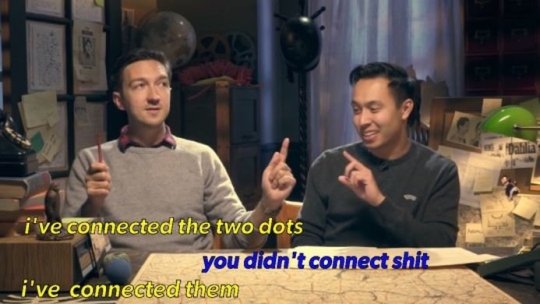
So how about we make a NEW squiggle, only 40 pixels high instead of 21? (We're gonna drop the pixels in blue, since threading diagrams won't work if you put a single end through two shafts.)


Next, we're going to chop up that squiggle and use it to create a new threading diagram in Fiberworks. I'm also using "tromp as writ" here to create the treadling pattern.

LOOK AT THAT. IT'S GOT MORE WAVES!! FIVE OF THEM!
And then we add back in the shadow by creating a space for a new end between each existing end:


And then add in the shadow. I'm using 4 as my number for the shadow offset since we're using 8 shafts. So shaft 1 shadows to shaft 5, shaft 2 shadows to shaft 6, etc.

And we're going to apply tromp as writ again to get:

AYYYYYY WE'RE GETTING CLOSE! I'm fairly certain that the reason why the Strickler treadling wasn't exactly tromp as writ had something to do with centering the pattern repeat a little more than this, but I don't really care about that so I'm going to leave this treadling the way that it is.
From here out, we need at add that weird vertical dividing line that chops up the center of the leaves. So we double the pattern repeat along the horizontal axis, and offset a 40 pixel section in the middle of the threading diagram by 1 pixel. I've also colored in the differences between the dark and light ends to help differentiate the original and shadowed curves a little bit more. (I also tried offsetting the colors of the warp ends by 1 as well like what we did in the log cabin example, but I ended up liking the way that this looked more.)

THERE SHE IS!!! MY PRECIOUS!!

From here on out, there is still a ton of work I need to do if I actually want to weave this cloak from scratch. I did buy roving in quantities that could be used to spin both the dark and light yarn (dark gray Gotland for the dark yarn, and dove gray merino + white alpaca for the light yarn), but there's still the matter of, like, handspinning a cloak's quantity of extremely fine yarn. I did start spinning the Gotland several years ago as fine as I could possibly manage, and got through maybe 20 ounces of it. However, I'm a much better spinner now and I'm not sure if the my skeins from several years ago would be suitable for weaving, or if it would be worth replicating what I did back then vs. just starting over with a new standard. There's also the possibility of just... buying weaving yarn if I want to skip that step, which would definitely save me a significant amount of time.
Anyway, thanks for reading this far and I hope it helped break down why this was so exciting for me!
#weaving#art#the lord of the rings#the fellowship of the ring#elven cloak#repeat after me i do not need a new hobby#i also do not need to immediately buy an 8-shaft loom#reference#inspiration#filing this away as a “someday” project
929 notes
·
View notes
Text
this is high calibre art
881 notes
·
View notes
Text

One of the other things I decided that needed to be added to Tessiël's kit this year was some form of portable light. Like many festivals, Castlefest's concerts tend to run well into the night and that's without adding the nightly Silent Disco so I wanted to have something to light my way on the path to the camping grounds that would still be a bit in character... However, I definitely wasn't going to use anything that would involve live fire . Castlefest has had several very dry runs in the past to the point that the wickerman almost couldn't be lit a couple of times, so anything involving open flame sounded supremely stupid. This actually opened quite a few options for me as I could use closed containers and materials that I normally wouldn't consider due to flammability.
In the end I settled for a glass storage jar around which I built this cute macrame pot hanger... as soon as the night falls I will then be able to light a couple of electric tealights, which will hopefully look very whimsical while also being completely safe.
2 notes
·
View notes
Text
This happened to me as well and I haven't posted any painting in ages. They asked me if I was open for comission on a post about the toddler clothes I had made for my nephew... I honestly thought they wanted me to sew clothes for them... I was probably a bit more naïve at first though I my scam radar was turned up higher than usual, I did check for example their blog which was empty but had a few likes so I figured this was someone who simply wasn't super active or very familiar with tumblr posting culture.... what made me definitely conclude it was a scam was the fact the "payment" email immediately got sent to my spambox, and that the email adress while seeming somewhat legit at first glance had numbers in it... I compared the mail to the mails I usually get from PayPal at which point I quickly saw they weren't the same... as soon as I saw that I send the whole email to paypal's phishing mail box ([email protected] for the netherlands) and told the scammer it was off... strangely that blog doesn't exist anymore
Hey guys let me tell you about advance fee scams
I hope y'all are familiar with these in this day and age, especially my artists out there, because they're incredibly common.
TL:DR: ANY kind of structure where you supposedly get money but have to give some of it back to someone should twig your scam radar, frankly. (re: @elljayvee)
About half an hour ago I posted a drawing and tagged it #artists on tumblr, and very quickly received this comment.

My scam radar went off immediately, due to the generic blog name and lack of any emotion in the comment, but I decided it might be an entertaining venture so I dmed them. They asked for a drawing "of these", and sent me a random selfie. I got the details and told them it would be $15, and they promptly offered me $300. At this point I know it's a scam, but I play along for funsies and give them my paypal. Shortly, they send me this image for "confirmation" (I blocked out my email)

And they began to insist that I checked my email. I looked in my spam folder and found the following email.

This is fake. This is not a thing. And the "you're to refund the $200.00 back" is the scam. They send vaguely official-looking emails at you to "prove" that they sent you the money, then have you send them $200 (or however much the scam is for). Then, surprise surprise, you're out $200.
I continued to play along for a bit, and in the second email "Paypal" told me that I had to refund the $200 before they could "credit the $300 to my account", along with these lovely threats.

And yeah, it's silly. But it's not silly if you don't know and get scammed. So. Spread, please! And thank you very much to @mlaurel for the opportunity to get these screenshots.
Anyone can be scammed, police, doctors, professors, cynics. The only thing they have in common is that they dont believe they could be scammed because they're too smart or savvy. ALL it takes is the right bait at the right time. (re: @evercaptor)
28K notes
·
View notes
Text
Every year when I prepare to go to Castlefest I think that this year will be the last year I will add new stuff to my castlefest persona, that after this Tessiël's costume will be complete....
And yet every year during Castlefest or in the months after I get new ideas for stuff to add...
Among this year's additions will two card woven ribbons to replace the cheap polysatin ribbons I used to braid into my hair....

The pattern is fairly simple since I doubt it is going to be super visible but interesting enough to add a little oomph and also looks pretty nice on the wrong side...
I misread the chart and mirrored the pattern meaning that the good side is the side facing away from me....
For those that it interests here are also 3 minutes of me clumsily chugging along as I try to keep my phone stable with my knee😅🤣
#my art#weaving#card weaving#weavers of tumblr#Tessiël of the Northern Woods#castlefest#tablet weaving
85 notes
·
View notes
Text

My fifth pair of sneaker socks of the year! These took a while longer than usual since I moved apartments in the meantime, decided I needed to do some embroidery as well and just plain lost interest for a while, but here they are!
My usual construction of a reinforced strong heel with asymmetric toes and a knit/purl pattern I found on stitch-maps.com
13 notes
·
View notes